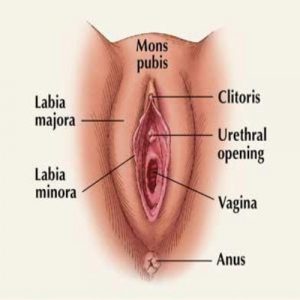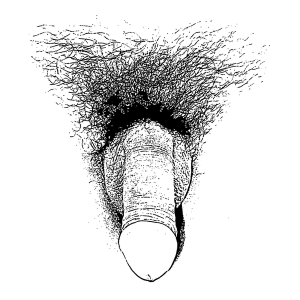“Back to life, back to reality…” (you’re all probably too young to know that song reference, but it’s a “banger” [do the kids say that anymore?], check it out here)
But anyway, let’s get back to the reality of our anatomy. Yes, we all have genitals and they all look super different from one another’s, which is super cool! Alike, but not alike alike. I dig it! What is not so cool, is that our culture, including the media (e.g., movies, magazines, pornography, music), messages from peers, stories we read have decided that there is one perfect genital composition for folks assigned male or female at birth (and don’t get me started on the space we don’t hold for folks that don’t check either of those boxes. Well yes, get me started on it because we’ll talk about it in lecture! But yes, even biological sex cannot be contained in two, dichotomous boxes. If I knew how to insert the mind blown emoji here, I would!).
We, the Western U.S., think penises should be “big”, long (not too long) and wide (but not too wide) and vulvas should appear cute, compact, and hairless (aka pre-pubescent, yuck!). If you’ve ever (and as the wonderful sex researcher Emily Nagoski recommends) looked down or pulled out a mirror you know that genitals don’t come in pretty little media ready packages. Instead, they come attached to amazingly unique, diverse, and complicated individuals and as such are unique, diverse, and complicated themselves.
In this chapter, we’re going to get a quick refresher on the components of anatomy and re-visit proper terminology and learn why using the correct terms is extremely helpful in a variety of settings.
The Female Anatomy
When not using a pet name or nickname, a lot of folks refer to female genitalia as THE VAGINA. But a vagina is not a monolith or a grand wizard like Oz, instead the vagina is just one part of an elaborate and spectacular genital system.
The image below shows the various parts that comprise the female vulva. First, the vulva is broad term used to refer to a female’s external genitalia. The mons pubis is the area over the public bone where the bulk of pubic hair grows. Females have two sets of genital “lips” and outer and inner set. The labia majora are the outer lips of the vagina, whereas the labia minora are the inner lips. Next, we have the vagina which is the reproductive canal. Females also have a urethral opening, which is separate in females compared to males, and where urine exits the body. And last, but certainly not least, the clitoris. The clitoris’s only function is sensation. So, it’s the feel good factory of the vulva. Although we use this broad term the clitoris has several different parts as well, including the glans, the visible part of the clitoris (which actually extends into the vaginal opening!), and small “hood” that cover it as well (and retracts back when stimulated).

The Male Anatomy
When we think of male genitals we often think of the penis, which unlike female genitals, is much more visible. Also, while female genitals are comprised of different parts that serve different functions, a male penis is a multi-purpose tool that is used for four tasks—sensation, penetration, ejaculation, and urination.
Although the penis itself a singular unit, it is comprised of three different parts (a) the root, which is internal and connects it to the pubic bone; (b) the shaft, the visible portion; and (c) the glans, which is the head of the penis, which also contains the urethral opening. Similar to the clitoris, the glans (head) is the most sensitive part of the penis, containing the most nerve endings. Finally, the scrotum, which contains the testes, extends below the penis and may or may not have hair.

A Word about Words
As either a communication major, or someone enrolled in a communication course, you probably know that words matter. If you’ve taken interpersonal communication with me you know that words have two levels of meaning—denotative and connotative.
Denotative is the literal, conventional, or as I like to remember it as the dictionary definition of a word. Connotative, on the other hand, is the implied, cultural, or emotional meaning of the word. We often shy away from using the denotative names for genitals and instead use abstract terms, nicknames, or pet names that often come with some very disturbing, gendered, and demeaning connotative meanings (A trend we’ll revisit when we discuss the language we use when discussing “having sex”). For instance, when I type in “pussy definition” the first entry in Meriam Webster reads:
- CAT
- A catkin of the pussy willow
That is the denotative definition. However, we all know that this word, sadly, has a lot of other connotative definitions. Heck, even Meriam Webster knows this as the remaining entries refer to a vulva, a female partner in sexual intercourse, and a weak man. These are the (disturbing and demeaning) connotative meanings of the word.
In addition to gendered and potentially demeaning connotative definitions associated with nicknames for genitals, not using the proper terminology can have other serious consequences. First, when we don’t use the proper terms for our anatomy we are implicitly suggesting that there is something shameful or dirty about our bodies or discussing them. Second, when we use pet or nicknames for genitals we make it harder to understand when someone, especially a child, is trying to tell us if something is wrong or if someone has done something inappropriate. For instance, if a young female reports to her teacher that her classmate touched her “peach” (her pet name for her vulva/vagina) her teacher might just think that her peer messed with her lunch and not even understand that this student is trying to report a sexual assault.
Additionally, using proper terminology from an early age instills confidence in children about their bodies and gives them the language to use with caregivers and/or health care providers when something hurts or is off. It also gives them the ability to clearly articulate challenges or concerns they have about their anatomy during puberty.
Moreover, becoming comfortable using proper terminology, not only for anatomy, but sexual behaviors as well helps to destigmatize sexual communication. It helps legitimize it and gives us the confidence to engage in it to talk to our healthcare providers, family members, and our sexual partners. Just because sex is a “natural” activity, it doesn’t mean it’s always easy. There are a lot of tricky parts to sex that we often don’t talk about, either because we are embarrassed, society tells us not to talk about it, or we just don’t have the skills to articulate our questions, concerns, experiences, or desires. Learning to use proper terminology is the first tool in our sexual communication toolbox.
Food for Thought
After reading this chapter, I want you to reflect on the following questions:
- What are some nicknames you (and/or your family) had for male and female genitals growing up? Why did you use these terms?
- How did the terminology you used for genitals, either nicknames or proper terminology, influence your views of your body? Others bodies? Communicating about sex?

